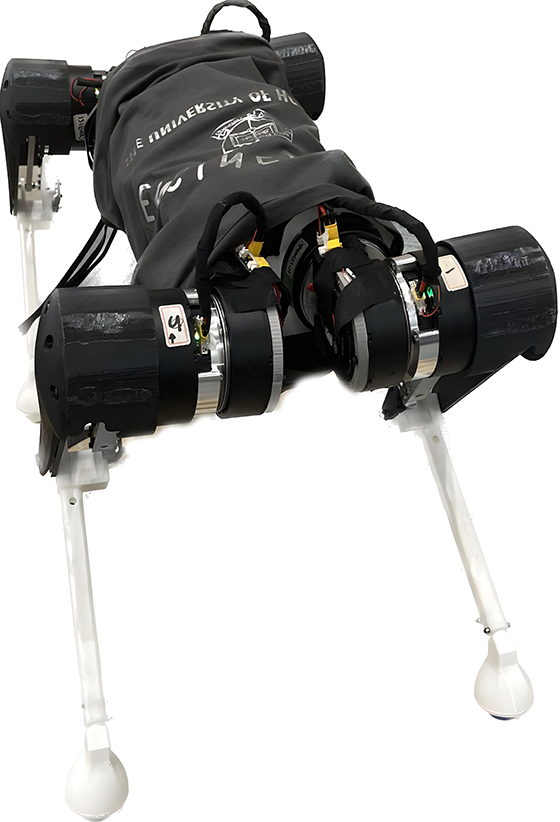November 2024 | Volume 26 No. 1
Pet Project
Listen to this article:
Professor Lu Peng of the Department of Mechanical Engineering is an expert in drones and ground robots. But after having children, he began to wonder how he could apply his skills to improve the life of his children. Why not a robopet?
Robots face similar control challenges to drones, but they could potentially be developed into a four-legged pet and monitor for his children, and have many other applications besides.
Since joining HKU in 2020, Professor Lu’s laboratory has made good progress in that direction. He and his team have overcome a significant mobility challenge for four-legged – or quadrupedal – robots and are now focussed on enhancing artificial intelligence (AI) for these machines to make them more autonomous and intelligent.
“Our ultimate goal is to make a robot that can behave like a real dog and be interactive and accompany children and the elderly. But first, it is absolutely mandatory that it can work in various terrains and environments. Otherwise, if you take it outside, it would fall all the time. Even in the home, it would collide with furniture,” Professor Lu said.
Moreover, the robot needs to be able to continue operating when something goes wrong. That is where his research has made important contributions.
Fall detection
Professor Lu and his team decided to build a quadrupedal robot from scratch, a process that was difficult and time-consuming. They decided to use electrical motors in their robots, rather than hydraulic actuators which he previously worked on. Hydraulic actuators can generate much larger force and power. However, ensuring that they perform with a high degree of precision remains challenging. In contrast, the performance of electrical motors has improved significantly and there is growing interest in their use because they are more precise and quiet.
Nonetheless, walking robots operate on 12 electrical motors so it is easy to imagine mishaps and malfunctions as they move. The team focussed on developing an algorithm to address these mobility challenges and they made quick progress. First, they developed an algorithm that could detect and address motor failures autonomously, so the robot could keep moving when one of its legs fails, without falling down. And second, they designed a framework that could be applied to any kind of quadrupedal robot, no matter its shape, length, mass or other features.
“There are many different types of quadrupedal robots and it is very time-consuming to design controllers for each type. Now we have this framework that can be applied to any morphology,” Professor Lu said.
With the locomotion challenge addressed, the team have turned to improving the agility of quadrupedal robots, such as enabling them to jump in any direction, and getting them to imitate the behaviour of another robot or animal. This work is nearing completion. They are also undertaking the more difficult task of embodying AI in robots.
Grand challenge
Currently, robots are not intelligent – they have preset movements, such as turning or dancing, but they are not interactive. This can make them ultimately boring as pets or companions because their functions are limited.
“We want to take the next step to enhance the robot’s autonomy so it can execute tasks and make decisions completely on its own. It is a sort of embodied AI. For instance, you could ask it to get a beer for you and it would process the order, make decisions and perform the task completely on its own,” Professor Lu said.
“Enhancing the robot’s intelligence is a grand challenge. It takes a lot of manpower, especially if you want it to do any kind of task. The research and industry are focussed on this now, and I think my team will make some progress soon.”
This is not just in the interest of fun because a robodog or other animal would have benefits for both people and industry, he said. While children and the elderly could have a companion that could respond to them and protect them, for instance by sending out an alarm if they fall or get injured. The robots could also serve as guide dogs for the blind or be used in policing or in factory inspections. “Ultimately, we want to make a robot that can behave like a real dog. This could probably be achieved in the near future,” Professor Lu added.

A quadrupedal robodog developed by Professor Lu’s laboratory.
Our ultimate goal is to make a robot that can behave like a real dog and be interactive and accompany children and the elderly.

Professor Lu Peng

